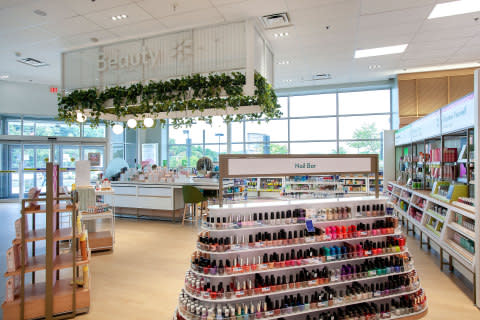How Rite Aid’s Bankruptcy Could Affect the Beauty Industry

Rite Aid’s filing for Chapter 11 bankruptcy on Sunday could have a residual impact on the mass market beauty industry. Rite Aid, the nation’s third-largest drug chain with sales of $24.1 billion across more than 2,300 stores, has been a proponent of launching emerging beauty brands to augment its assortment of traditional mass market companies.
Dwarfed by the size of the two drugstore leaders, Walgreens and CVS, Rite Aid differentiated its beauty mix with beauty lines not always found at competitors. In 2020 Rite Aid revealed a splashy wellness-focused beauty department in its Store of the Future design loaded with indie brands, ramped-up services and fixtures inspired by higher-end beauty retailers.
More from WWD
Learnings from the handful of elevated beauty departments were translated into the existing store beauty departments. Among the brands gaining a shot in mass market with Rite Aid include Doll Face, Kokie, Essano and Ella + Mila. Rite Aid’s locations in rural markets have also made the stores a go-to for traditional mass brands like L’Oréal, E.l.f., CoverGirl, Wet ‘n’ Wild, Sally Hansen and Revlon. When many chains pared back on Revlon, Rite Aid maintained the brand’s space.
Beyond beauty, Rite Aid expanded delivery with apps like Door Dash, offered Afterpay, boosted the number of private labels and tested a smaller store format.
There are so many points of purchase for beauty that are convenient and opportunities for discovery that this is a minor ripple for beauty shoppers…”
Marie Driscoll, The New School and FIT
The efforts were not enough to stave off filing for Chapter 11. “It was always a matter of when, not if, Rite Aid would file for bankruptcy,” said Neil Saunders, managing director of GlobalData. “The company has been deep in the red for the past six years, notching up combined net losses of $2.9 billion. It also has $3.3 billion of long-term debt sitting on the balance sheet which, during the last fiscal quarter, cost it some $65 million to service. Its assets exceed its liabilities by $947 million — a figure that seems to constantly widen. Against this financial backdrop, Rite Aid simply isn’t a viable entity: it is basically running on the fumes of cash it generates in the day-to-day business.”
The chain also announced that Jeffrey Stein was appointed chief executive officer, chief restructuring officer and a member of the board of directors. He succeeds Elizabeth Burr, who has served as interim CEO since January 2023 following the departure of Heyward Donigan, the former president and CEO. Stein has experience in transforming businesses that are undergoing financial restructurings. In a statement, he said his priorities will include overseeing the actions underway to strengthen the company’s financial position and “further advance its journey to reach its full potential as a modern neighborhood pharmacy.” In addition to Stein, Rite Aid has appointed Carrie Teffner and Paul Keglevic to its board of directors.
Following the Chapter 11 bankruptcy announcement, S&P Global Ratings downgraded Rite Aid to a D from CCC rating.

Rite Aid’s efforts to boost front-of-store sales collided with more cost-conscious shoppers on the hunt for lower prices offered at Walmart and dollar stores. To that end, front-of-store sales declined by 4.4 percent in the latest quarter.
The final straw was pending lawsuits for opioid settlements, which Saunders estimates could end up costing the company around $1 billion. “Bankruptcy is the only sensible option as it will allow Rite Aid to restructure its debt and to potentially address the various opioid settlements as part of one process.” Walgreens and CVS, with their deep pockets, were better prepared to pay out about $5 billion each to settle lawsuits over the toll of opioids.
Rite Aid said it secured a commitment for $3.45 billion in new financing from certain of its lenders that expected to provide sufficient liquidity to support the company throughout this process. The chain is expected to close some of its stores — some reports peg closures at up to 500 doors.
Scott Emerson, president of the Emerson Group, said Chapter 11 gives Rite Aid the opportunity to rebuild. “They have been under extreme financial debt for over 20 years and could not get out from under it to make progress,” said Emerson. He hopes new leadership will become visible in the industry “and come out from behind Zoom meetings.”
Despite Rite Aid’s woes, industry sources said there is a need for a third major drug chain in a consolidated industry. “Not surprising. Rite Aid has been burdened by an untenable load of debt that has made it hard to innovate and compete with the bigger chains. But there are still a lot of loyal shoppers who appreciate the convenience and service of their local Rite Aid, so one can only hope this allows the company to get back to focusing on providing affordable health care to them as quickly as possible,” said Wendy Liebmann, CEO and founder of WSL Strategic Retail.
From a beauty standpoint, consumers could be able to secure beauty needs in other outlets if stores close. “Health and beauty aids accounted for 4.3 percent of Rite Aid’s fiscal 2023 sales, approximately $1 billion,” said Marie Driscoll, adjunct professor at The New School and FIT. “Consumers are likely to transfer purchases to Amazon, Ulta [Beauty] as well as Ulta at Target and Sephora at Kohl’s with Rite Aid store closings. There are so many points of purchase for beauty that are convenient and opportunities for discovery that this is a minor ripple for beauty shoppers and these alternatives provide a superior shopping experience. CVS, Walgreens and Walmart will benefit as well.”
However, one beauty brand executive said he hopes Rite Aid emerges with a core of stores that will continue to provide incubation for smaller brands. “Rite Aid has some very loyal customers who like their beauty departments. Their nail sections are among the best in the industry. The upgrades made over the past few years brought in an upscale department that rivals Sephora, especially in smaller markets. Brands who can’t start out at Walgreens or Walmart get an opportunity to prove their worth at Rite Aid,” he concluded.
Saunders agreed Rite Aid plays an important role. “The business has a proposition that is far from irrelevant — especially across many of the rural areas it serves. Unfortunately, bankruptcy may see more shop closures which, unless other chains step in to acquire store assets, will leave some holes in the pharmacy landscape and potentially runs the risk of pharmacy deserts opening up in some locations. While Rite Aid should be able to emerge from bankruptcy, unless it is bought by a larger firm, it will still have struggles. Rite Aid’s margins are already relatively thin — which is a consequence of it being somewhat too small. Although it has some buying agreements in place, Rite Aid does not have the scale or negotiating power of the larger pharmacy chains.”
Best of WWD

